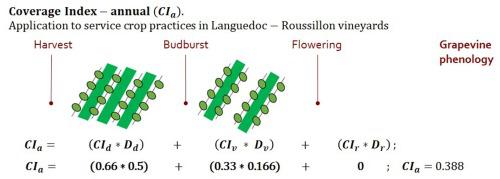当前位置:
X-MOL 学术
›
Eur. J. Agron.
›
论文详情
Our official English website, www.x-mol.net, welcomes your
feedback! (Note: you will need to create a separate account there.)
Spatial and temporal diversity of service plant management strategies across vineyards in the south of France. Analysis through the Coverage Index
European Journal of Agronomy ( IF 4.5 ) Pub Date : 2021-02-01 , DOI: 10.1016/j.eja.2020.126191 Hugo Fernández-Mena , Hélène Frey , Florian Celette , Léo Garcia , Karim Barkaoui , Laure Hossard , Audrey Naulleau , Raphaël Métral , Christian Gary , Aurélie Metay
European Journal of Agronomy ( IF 4.5 ) Pub Date : 2021-02-01 , DOI: 10.1016/j.eja.2020.126191 Hugo Fernández-Mena , Hélène Frey , Florian Celette , Léo Garcia , Karim Barkaoui , Laure Hossard , Audrey Naulleau , Raphaël Métral , Christian Gary , Aurélie Metay

|
Abstract ‘Service plants’ include spontaneous vegetation or sown species of cover crops associated with perennial crops in the rows or inter-rows with a high potential to provide ecosystem functions and services. In vineyards, service plants target specific services depending on the management strategy implemented by the winegrower, including the plant species, the surface covered, the plant growth control and destruction date. Understanding the management strategies linked to their associated target services at the regional scale is necessary to better help winegrowers, advisers and policy makers regarding an adapted use of service plants. To do this, we conducted a survey in 2016 among 334 winegrowers in Languedoc-Roussillon region in France, enquiring about their service plant management practices during the season 2014–2015. Given the diversity of the strategies of service plant management, we proposed a typology analyzing their spatial and temporal dimensions. Further, we present a Coverage Index (CI), which combines both temporal and spatial dimensions of the service plant management strategies. We conducted a multiple components analysis and clustering to create a vineyard typology and applied linear models to find correlations between the CI and specific vineyard characteristics. Three quarters of interviewed winegrowers sowed or maintained service plants in their vineyards; 41 % used a winter service plant strategy; 8.4 % a semi-permanent and 27.3 % a permanent service plant strategy. The preferred surface coverage strategy was full surface during grapevine dormancy and its reduction to half of the inter-rows after grapevine budburst. However, the diversity of surface coverage strategies during the grapevine vegetative period was remarkable. Lower water resources and specific soil characteristics were not linked to the service plant management strategies. Higher CI was associated with vineyards presenting quality labels (PDO and Organic), independent winemaking and lower target yields, showing that the added value of producing high quality wine plays an important role when implementing service plants in vineyards. Overall, our study showed: i) the popularity of spontaneous service plant strategies; ii) the spatial and temporal diversity of service plant management strategies and iii) the utility of the CI to study the implementation of service plants and to understand the motivations and constraints of their use.
中文翻译:

法国南部葡萄园服务工厂管理策略的时空多样性。通过覆盖率指数分析
摘要 “服务植物”包括自发植被或与多年生作物相关的覆盖作物品种,它们在行或行间具有很高的提供生态系统功能和服务的潜力。在葡萄园中,服务工厂根据葡萄种植者实施的管理策略提供特定服务,包括植物种类、覆盖面积、植物生长控制和销毁日期。了解与区域范围内相关目标服务相关的管理策略对于更好地帮助葡萄酒种植者、顾问和政策制定者调整使用服务工厂是必要的。为此,我们在 2016 年对法国朗格多克-鲁西永地区的 334 名葡萄种植者进行了一项调查,询问他们在 2014-2015 季节期间的服务工厂管理实践。鉴于服务工厂管理策略的多样性,我们提出了一种分析其空间和时间维度的类型学。此外,我们提出了一个覆盖指数 (CI),它结合了服务工厂管理策略的时间和空间维度。我们进行了多成分分析和聚类以创建葡萄园类型并应用线性模型来找到 CI 与特定葡萄园特征之间的相关性。四分之三的受访葡萄种植者在他们的葡萄园中播种或维护服务植物;41 % 使用冬季服务工厂策略;8.4% 为半永久性和 27.3% 为永久性服务工厂战略。首选的表面覆盖策略是葡萄树休眠期间的全表面覆盖,葡萄树萌芽后将其减少到行间的一半。然而,葡萄藤生长期间地表覆盖策略的多样性是显着的。较低的水资源和特定的土壤特征与服务植物管理策略无关。较高的 CI 与提供质量标签(PDO 和有机)、独立酿酒和较低目标产量的葡萄园有关,这表明在葡萄园中实施服务工厂时,生产优质葡萄酒的附加值起着重要作用。总的来说,我们的研究表明:i)自发服务工厂策略的流行;ii) 服务工厂管理策略的空间和时间多样性以及 iii) CI 在研究服务工厂的实施和了解其使用的动机和限制方面的效用。
更新日期:2021-02-01
中文翻译:

法国南部葡萄园服务工厂管理策略的时空多样性。通过覆盖率指数分析
摘要 “服务植物”包括自发植被或与多年生作物相关的覆盖作物品种,它们在行或行间具有很高的提供生态系统功能和服务的潜力。在葡萄园中,服务工厂根据葡萄种植者实施的管理策略提供特定服务,包括植物种类、覆盖面积、植物生长控制和销毁日期。了解与区域范围内相关目标服务相关的管理策略对于更好地帮助葡萄酒种植者、顾问和政策制定者调整使用服务工厂是必要的。为此,我们在 2016 年对法国朗格多克-鲁西永地区的 334 名葡萄种植者进行了一项调查,询问他们在 2014-2015 季节期间的服务工厂管理实践。鉴于服务工厂管理策略的多样性,我们提出了一种分析其空间和时间维度的类型学。此外,我们提出了一个覆盖指数 (CI),它结合了服务工厂管理策略的时间和空间维度。我们进行了多成分分析和聚类以创建葡萄园类型并应用线性模型来找到 CI 与特定葡萄园特征之间的相关性。四分之三的受访葡萄种植者在他们的葡萄园中播种或维护服务植物;41 % 使用冬季服务工厂策略;8.4% 为半永久性和 27.3% 为永久性服务工厂战略。首选的表面覆盖策略是葡萄树休眠期间的全表面覆盖,葡萄树萌芽后将其减少到行间的一半。然而,葡萄藤生长期间地表覆盖策略的多样性是显着的。较低的水资源和特定的土壤特征与服务植物管理策略无关。较高的 CI 与提供质量标签(PDO 和有机)、独立酿酒和较低目标产量的葡萄园有关,这表明在葡萄园中实施服务工厂时,生产优质葡萄酒的附加值起着重要作用。总的来说,我们的研究表明:i)自发服务工厂策略的流行;ii) 服务工厂管理策略的空间和时间多样性以及 iii) CI 在研究服务工厂的实施和了解其使用的动机和限制方面的效用。











































 京公网安备 11010802027423号
京公网安备 11010802027423号